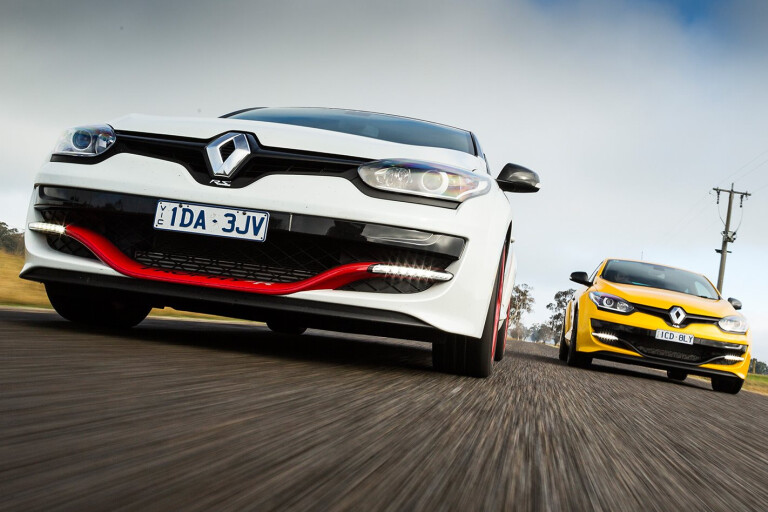
Cars are much like cuisine. Not in taste, of course – though some my own early culinary attempts weren’t far off – but a successful outcome in both respects depends on the correct ingredients being assembled in the correct order.
A Ferrari 488 GTB or Porsche 911 GT3 is like the chef’s special at Vue de Monde or Quay, the very finest ingredients painstakingly prepared by masters of the craft. But you’re not always in the mood for a fancy meal, often you just want pizza.
That’s where hot hatches come in. They’re the comfort food on the automotive menu, and one of the tastiest offerings of recent times has been Renault’s Sport Megane. Based as it is on a humdrum hatchback, the ingredients are simple – front-wheel drive, transversely-mounted turbocharged four-cylinder engine, manual gearbox – but the recipe is deceptively complex.
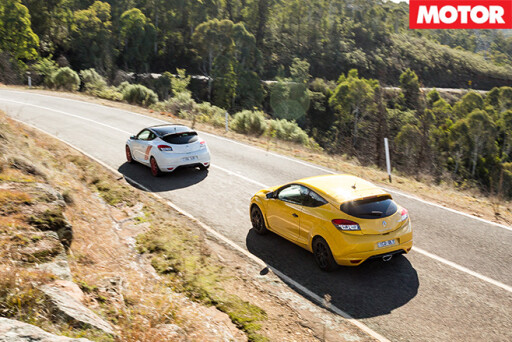 Renault itself hasn’t always had the hang of it. Australia’s first exposure to a hot Megane was the 225 in 2005; a brisk but uninvolving effort smothered by electronics. But the French learned fast. Less than three years later the F1 R26 asserted itself as one of the finest front drivers ever, finishing sixth in our 2007 Performance Car Of The Year test, beaten only by the likes of the Lamborghini Gallardo Superleggera, Porsche GT3 and Audi R8.
Renault itself hasn’t always had the hang of it. Australia’s first exposure to a hot Megane was the 225 in 2005; a brisk but uninvolving effort smothered by electronics. But the French learned fast. Less than three years later the F1 R26 asserted itself as one of the finest front drivers ever, finishing sixth in our 2007 Performance Car Of The Year test, beaten only by the likes of the Lamborghini Gallardo Superleggera, Porsche GT3 and Audi R8.
Megane III continued this giant-killing momentum with the RS250 going straight to the top of the hot-hatch class upon its release in 2010, and a continuous stream of improvements has kept it there despite a wave of new opposition including Holden’s Astra VXR and VW’s Golf GTI Performance.
With the current generation entering its twilight, however, Renault has bestowed on us the Sport Megane RS275 Trophy-R, arguably the most focused front-driver ever sold in Australia. Just 250 will be offered worldwide, with Australia allocated a fifth of that tally; the second-highest global order commensurate with the voracious Aussie appetite for Renault Sport products.
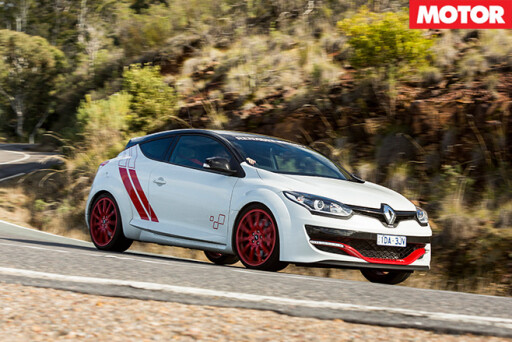 The catalyst for the Trophy-R’s creation was Renault’s desire to reclaim the front-wheel-drive production lap record around the Nürburgring. In June 2014 the Trophy-R duly achieved its goal with a 7min54.36sec lap, four seconds faster than the previous record held by the Seat Leon Cupra. Honda has since bettered that with its new Civic Type R, but there is a question mark over that car’s production status.
The catalyst for the Trophy-R’s creation was Renault’s desire to reclaim the front-wheel-drive production lap record around the Nürburgring. In June 2014 the Trophy-R duly achieved its goal with a 7min54.36sec lap, four seconds faster than the previous record held by the Seat Leon Cupra. Honda has since bettered that with its new Civic Type R, but there is a question mark over that car’s production status.
Corporate willy-waving aside, the need to shave tenths around the famed Green Hell meant no part of the Trophy-R went untouched in search of speed. However, even a limited-edition hot hatchback has to remain relatively affordable, which meant slathering the car in carbonfibre and giving it 300kW was off the agenda. Instead, the talented folk from Dieppe had to get smart.
Outputs from the 2.0-litre turbocharged F4RT engine (go on, have a giggle, we do) remain the same 201kW and 360Nm as the regular Trophy, but a 92kg diet does wonders for the power-to-weight ratio, lifting it from 146 to 155kW/tonne.
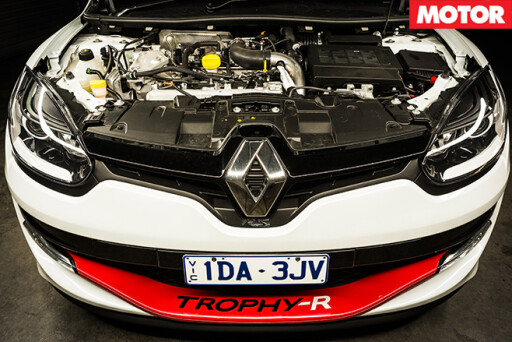 Kilograms have been shaved everywhere; the Recaro polycarbonate seats account for 42kg, the lithium-ion battery another 15kg, the front brake discs lose a further 3kg, with most of the rest accounted for by the deletion of equipment such as the rear seats and, in this particularly gaunt press car, the sat-nav, radio and air-con.
Kilograms have been shaved everywhere; the Recaro polycarbonate seats account for 42kg, the lithium-ion battery another 15kg, the front brake discs lose a further 3kg, with most of the rest accounted for by the deletion of equipment such as the rear seats and, in this particularly gaunt press car, the sat-nav, radio and air-con.
However, what Renault taketh away with the one hand it giveth with the other, and the addition of Öhlins adjustable dampers with composite springs and Michelin Pilot Sport Cup 2 tyres – the same rubber you’ll find on the Porsche 911 GT3 and Ferrari 458 Speciale – goes a long way to explaining the Trophy-R’s record-setting speed.
Such high-level componentry doesn’t come cheap of course, and the Trophy-R’s $61,990 ask is a whopping $18,000 more than the base RS265, which is a pretty handy device in its own right. So, can the stickered-up, limited-edition special really justify its massive price premium when the two cars are so fundamentally similar?
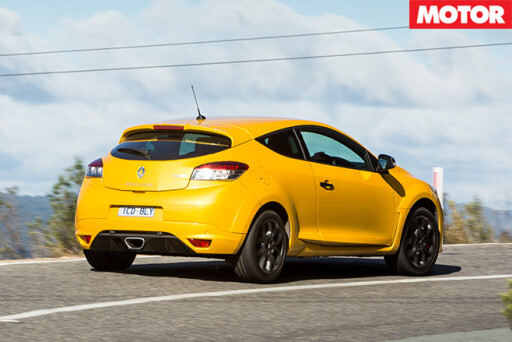 There’s certainly little separating the two in a straight line. The base RS265 carries an extra 127kg, but with only six less kilowatts and an identical amount of newton metres, the weight penalty matters less than the available traction.
There’s certainly little separating the two in a straight line. The base RS265 carries an extra 127kg, but with only six less kilowatts and an identical amount of newton metres, the weight penalty matters less than the available traction.
A fluke of a launch nets 0-100km/h in 5.86sec and 13.86sec at 169.20km/h for the quarter, impressive numbers for a front-drive hot hatch. But the Trophy-R is faster still, if only slightly, passing 100km/h in 5.77sec and crossing the 400m mark in 13.79sec at 170.02km/h.
It feels like there is another tenth or two in it, but trying to launch with the appropriate amount of wheel slip results in diabolical axle tramp; on this day at least, it doesn’t want to hook up. Mind you, a mid-to-high 13 isn’t mucking about, and the Trophy-R’s lighter weight is evident in its rolling acceleration, edging the RS265 from 80-120km/h by at least a tenth in every gear.
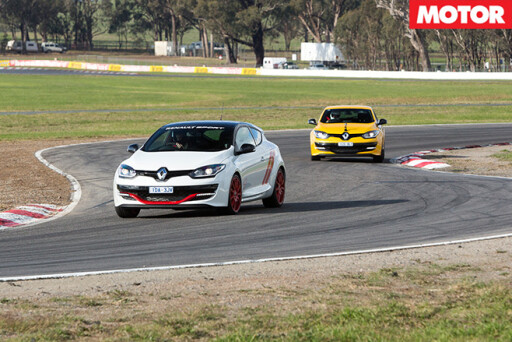 But no-one buys a hot hatch to go drag racing; part of the appeal of the Renault Sport breed is their suitability for the circuit, and Winton’s tight, technical layout allows us to explore the outer limits of our two contenders. First, however, there’s the small matter of 250km of highway to deal with, and yours truly draws the short straw and has to pilot the car with no radio. While the lack of audio is a pain, it’s debatable whether you’d hear it anyway, such is the din generated by the Cup tyres in a car with minimal sound deadening.
But no-one buys a hot hatch to go drag racing; part of the appeal of the Renault Sport breed is their suitability for the circuit, and Winton’s tight, technical layout allows us to explore the outer limits of our two contenders. First, however, there’s the small matter of 250km of highway to deal with, and yours truly draws the short straw and has to pilot the car with no radio. While the lack of audio is a pain, it’s debatable whether you’d hear it anyway, such is the din generated by the Cup tyres in a car with minimal sound deadening.
With a set of headphones plugged into an iPhone blocking out the racket, the Trophy-R is a relatively painless long-distance transporter. The ride is a little sharp at highway speeds – a trait shared by the RS265 – and the fixed-back driver’s seat is set oddly high. But the kilometres pass with little fuss.
Patchy rain has left Winton damp in spots, but thankfully not in places that are too detrimental to a lap time. The RS265 is up first to set a benchmark in terms of both speed and driving impression, and it impresses from the moment you exit pit lane. In Sport mode, throttle response is superb for a turbo engine, and there’s plenty of low-down torque and a strong mid-range.
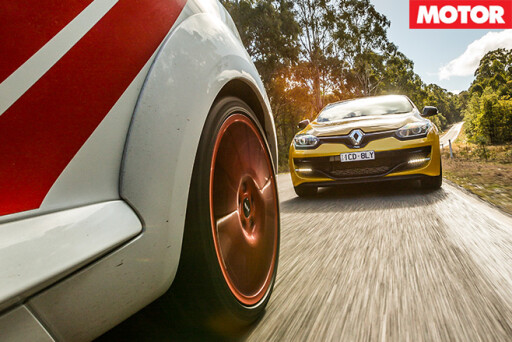 Its best work is done by 6000rpm, but the broad power band gives the option of staying in third for Winton’s tighter turns to improve traction – the diff can be a little inconsistent, especially when it gets hot – and limit cog-swapping. This is welcome given the Megane’s six-speed manual isn’t the slickest ’box around. Otherwise, there’s very little to fault. The brakes and tyres hold up well, and its friendly on-limit behaviour results in a best lap of 1:43.0.
Its best work is done by 6000rpm, but the broad power band gives the option of staying in third for Winton’s tighter turns to improve traction – the diff can be a little inconsistent, especially when it gets hot – and limit cog-swapping. This is welcome given the Megane’s six-speed manual isn’t the slickest ’box around. Otherwise, there’s very little to fault. The brakes and tyres hold up well, and its friendly on-limit behaviour results in a best lap of 1:43.0.
It’s a high benchmark and it’s difficult to imagine where the Trophy-R will improve. The simple answer is... everywhere. It immediately feels more urgent leaving pit lane, but care is needed until the tyres reach operating temperature. On track the intelligence of the mods becomes evident, as every aspect of the car’s performance is subtly improved. The trick Michelins improve braking, traction and lateral grip, while the lighter weight not only makes the car faster, but much more agile.
The first flying lap is a 1:40.5, which improves to a 1:40.4. Encountering traffic on one lap still results in a 1:40.5, so a sub-1:40 is there for the taking, making it blisteringly fast for a front-wheel drive hot hatch. It’s pure magic on a circuit, getting better the harder you drive it and sounding like it’s got anti-lag, such is the cacophony of pops and bangs on the over-run.
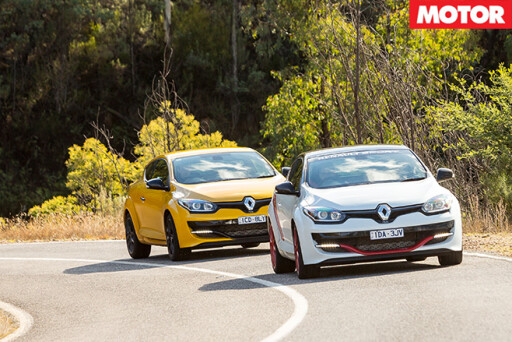 Unfortunately, the gearbox is even more recalcitrant than in the RS265 and the brakes go very long after only two laps, though this issue is later traced to old brake fluid. Even in the wet the Trophy-R has tenacious grip, and only when standing water starts to form do the tyres fall out of their operating window and fourth-gear wheelspin becomes the norm.
Unfortunately, the gearbox is even more recalcitrant than in the RS265 and the brakes go very long after only two laps, though this issue is later traced to old brake fluid. Even in the wet the Trophy-R has tenacious grip, and only when standing water starts to form do the tyres fall out of their operating window and fourth-gear wheelspin becomes the norm.
On-track superiority established, it’s time to see if the Trophy-R can repeat the trick on the road. As an aside, one area this hardcore Megane has a clear advantage over other track specials is its practicality – stripping out the rear seats has resulted in a cavernous luggage area. So we undo months of hard work by Renault Sport by stuffing its lightweight special full of camera gear.
This seems as good a moment as any to swap back into the RS265 for a run over the challenging Mansfield-Whitfield road in Victoria’s High Country, one of the state’s finest driving roads. The conditions are about as difficult as they come – constant bumps with plenty of surface changes and every corner a different level of damp – yet the Megane just eats it up. Care has to be taken on the exit of wet corners lest the front wheels flare up and drag the nose wide, but it travels at a pace that would give serious sportscars a real headache.
 With confidence building, the rear is brought subtly into play, easing the load on the front tyres. Plenty of enthusiasts look down their noses at front-wheel drive cars, but there’s a real art to driving one fast. An art that’s probably more challenging than rear-wheel drive, with its 50:50 weight balance and even distribution of cornering loads.
With confidence building, the rear is brought subtly into play, easing the load on the front tyres. Plenty of enthusiasts look down their noses at front-wheel drive cars, but there’s a real art to driving one fast. An art that’s probably more challenging than rear-wheel drive, with its 50:50 weight balance and even distribution of cornering loads.
On the same stretch of tricky tarmac, it takes commitment to uncover the Trophy’s extra talent; unsurprisingly, given how much DNA they share, the two cars feel very similar, so the differences are reasonably subtle – the Trophy-R’s steering is slightly lighter, its turn-in a fraction sharper.
 However, it’s on the dry, smooth downhill run into Mansfield that Renault’s hardcore hatch lifts itself to a higher plateau, a realm occupied by only the very finest performance cars like the BMW M3 and Porsche 911. In short order you are braking later, turning harder and accelerating more forcefully, your brain sucked into a loop of ‘faster, faster’.
However, it’s on the dry, smooth downhill run into Mansfield that Renault’s hardcore hatch lifts itself to a higher plateau, a realm occupied by only the very finest performance cars like the BMW M3 and Porsche 911. In short order you are braking later, turning harder and accelerating more forcefully, your brain sucked into a loop of ‘faster, faster’.
Commit to corners at what seems like insane speeds and it just grips and goes; the Trophy-R taking everything you can throw at it and yet coming back for more. You might only have a drive like this a couple of times a year, but it’s an experience that a base RS265 will never be able to replicate.
There’s no doubt the RS265 offers 95 per cent of the experience for 70 per cent of the cost. And for most people, the Trophy-R’s extra ability will be redundant or irrelevant. For the committed few, however, well, it will be like the best burger you’ve ever eaten. The ingredients may be relatively simple, but the preparation and construction have created something truly magnificent.
| Megane RS265 | Megane RS275 Trophy-R | |
| Body | 2-door, 5-seat hatch | 2-door, 2-seat hatch |
| Drive | front-wheel | front-wheel |
| Engine | 1998cc inline-4, DOHC, 16v, turbo | 1998cc inline-4, DOHC, 16v, turbo |
| Bore/stroke | 82.7 x 93.0mm | 82.7 x 93.0mm |
| Compression | 8.6:1 | 8.6:1 |
| Power | 195kW @ 5500rpm | 201kW @ 5500rpm |
| Torque | 360Nm @ 3000rpm | 360Nm @ 3000rpm |
| Power/weight | 142kW/tonne | 156kW/tonne |
| Transmission | 6-speed manual | 6-speed manual |
| Weight | 1411kg | 1284kg |
| Suspension | struts, A-arms, coil springs, anti-roll bar (f); torsion beam, coil springs, anti-roll bar (r) | struts, A-arms, coil springs, anti-roll bar (f); torsion beam, coil springs, anti-roll bar (r) |
| L/W/H | 4320/1848/1422mm | 4320/1848/1422mm |
| Wheelbase | 2646mm | 2646mm |
| Tracks | 1546/1547mm (f/r) | 1546/1547mm (f/r) |
| Steering | electrically-assisted rack-and-pinion | electrically-assisted rack-and-pinion |
| Brakes | 340mm ventilated discs, 4-piston calipers (f); 290mm solid discs, single-piston calipers (r) | 340mm ventilated discs, 4-piston calipers (f); 290mm solid discs, single-piston calipers (r) |
| Wheels | 18.0 x 8.25-inch (f/r) | 19.0 x 8.25-inch (f/r) |
| Tyres | 235/40 ZR18 95Y (f/r) Michelin Pilot Sport PS2 | 235/35 ZR19 (f/r); Michelin Pilot Sport Cup 2 |
| Price as tested | $43,990 | $61,990 |
| Positives | Great engine; engaging handling; strong brakes; value | The Megane experience turned up to 11; a hot hatch legend |
| Negatives | Ride can be hard work; notchy gearbox; inconsistent diff | Possibly too compromised for daily use; recalcitrant gearbox |
| Star Rating | 4/5 | 4/5 |

COMMENTS